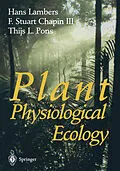'Physiological ecology' refers to the interaction between organisms and their environment. This textbook describes the ways in which the physiological ecology of plants influences their growth, reproduction and distribution. The book is notable for its integration of molecular -, whole plant-, and ecosystem-level processes. It features numerous boxed entries that provide extended discussions of selected issues, a glossary, and an extensive bibliography. The book also contains hundreds of figures. It is suitable for use in plant ecology courses, as well as classes ranging from plant physiology to plant molecular biology.
Klappentext
This textbook is remarkable for emphasising that the mechanisms underlying plant physiological ecology can be found at the levels of biochemistry, biophysics, molecular biology and whole-plant physiology. The authors begin with the primary processes of carbon metabolism and transport, plant-water relations, and energy balance. After considering individual leaves and whole plants, these physiological processes are then scaled up to the level of the canopy. Subsequent chapters discuss mineral nutrition and the ways in which plants cope with nutrient-deficient or toxic soils. The book then looks at patterns of growth and allocation, life-history traits, and interactions between plants and other organisms. Later chapters deal with traits that affect decomposition of plant material and with plant physiological ecology at the level of ecosystems and global environmental processes.
Inhalt
* Assumptions and Approaches * Photosynthesis, Respirations and Long-distance Transport * Water Relations * Leaf Energy Budgets: Effects of Radiation and Temperature * Scaling Up * Plant Nutrition * Growth and Allocation * Life Cycles * Biotic Influences * Role in Ecosystem and Global Processes * Glossary
